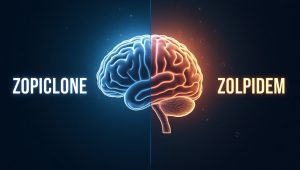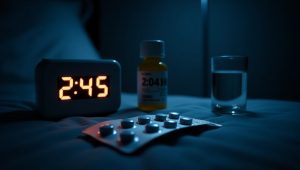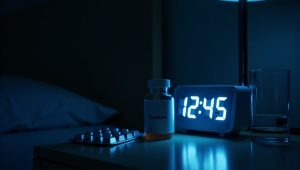
 Zopiclone (brand name Zimovane) is a non-benzodiazepine sedative-hypnotic medication primarily used to treat insomnia. It works by enhancing the effect of GABA, a neurotransmitter that inhibits brain activity, helping to induce sleep and reduce nighttime awakenings.
Zopiclone (brand name Zimovane) is a non-benzodiazepine sedative-hypnotic medication primarily used to treat insomnia. It works by enhancing the effect of GABA, a neurotransmitter that inhibits brain activity, helping to induce sleep and reduce nighttime awakenings.
This medication is particularly effective for those who have difficulty staying asleep throughout the night. It’s typically prescribed for short-term use of up to 4 weeks to prevent dependency issues.

Zolpidem (brand name Ambien) is also a non-benzodiazepine sedative-hypnotic medication used to treat insomnia. Like Zopiclone, it affects GABA receptors in the brain but targets a more specific receptor subtype.
Zolpidem is known for its rapid onset of action, making it particularly helpful for people who have trouble falling asleep initially. Doctors typically prescribe it for an even shorter duration than Zopiclone—usually no more than 2 weeks.

Zopiclone enhances the action of gamma-aminobutyric acid (GABA), the main inhibitory neurotransmitter in the central nervous system. It binds to GABA-A receptors, but affects multiple receptor subtypes, which explains its broader effects on sleep architecture.
This mechanism helps reduce brain activity, making it easier to fall asleep and stay asleep throughout the night. The broader receptor activity contributes to Zopiclone’s effectiveness for maintaining sleep.
Zolpidem also works on GABA-A receptors but is more selective than Zopiclone. It primarily binds to the alpha-1 subunit of these receptors, which is mainly responsible for the sedative effects rather than the anxiolytic (anti-anxiety) effects.
This selective binding explains why Zolpidem works quickly to induce sleep but may be less effective at maintaining sleep throughout the night compared to Zopiclone.
| Feature | Zopiclone | Zolpidem |
| Brand Names | Zimovane | Ambien, Stilnox |
| Standard Dosage | 3.75mg or 7.5mg | 5mg or 10mg |
| Onset of Action | 30-60 minutes | 15-30 minutes |
| Half-life | 5-6 hours | 2-3 hours |
| Duration of Effect | 6-8 hours | 4-5 hours |
| Best For | Difficulty staying asleep | Difficulty falling asleep |
| Maximum Recommended Use | Up to 4 weeks | Up to 2 weeks |
| Metallic Taste Side Effect | Common | Rare |
| Next-day Drowsiness | More likely | Less likely |
Not sure which medication might be right for your sleep issues?
 Zopiclone tends to be more effective for people who can fall asleep but have trouble staying asleep throughout the night. Its longer half-life means it remains active in your system for a longer period, helping to prevent middle-of-the-night or early morning awakenings.
Zopiclone tends to be more effective for people who can fall asleep but have trouble staying asleep throughout the night. Its longer half-life means it remains active in your system for a longer period, helping to prevent middle-of-the-night or early morning awakenings.
Studies have shown that Zopiclone can improve total sleep time and reduce the number of awakenings during the night. If maintaining sleep is your primary issue, Zopiclone might be the more suitable option.
 Zolpidem is particularly effective for sleep onset insomnia—difficulty falling asleep initially. Its rapid action means most people fall asleep within 15-30 minutes of taking it, compared to the 30-60 minutes that Zopiclone typically requires.
Zolpidem is particularly effective for sleep onset insomnia—difficulty falling asleep initially. Its rapid action means most people fall asleep within 15-30 minutes of taking it, compared to the 30-60 minutes that Zopiclone typically requires.
If your main struggle is lying awake for hours trying to fall asleep, but you generally stay asleep once you do, Zolpidem may be the better choice. Its shorter half-life also means less likelihood of morning grogginess.

Both medications can cause dependence and withdrawal symptoms if used for extended periods. They should only be used short-term as prescribed by your doctor. Never increase your dose without medical supervision.


Do not take either medication unless you have time for a full night’s sleep (7-8 hours). Taking these medications and not getting enough sleep can lead to memory problems and increased risk of accidents the next day.

Both Zopiclone and Zolpidem can interact with other substances, potentially causing dangerous effects. Be particularly cautious with:
| Substance | Potential Interaction |
| Alcohol | Severely increases sedation, respiratory depression, and impairment. Never combine. |
| Other CNS Depressants | Opioids, benzodiazepines, and other sedatives can cause dangerous additive effects. |
| Antidepressants | Some may increase or decrease effectiveness or side effects. |
| Antifungals | Ketoconazole and similar medications can increase blood levels of these sleep medications. |
| Rifampin | May decrease effectiveness of both medications. |
These medications should be used with caution or avoided entirely in people with:
 Both Zopiclone and Zolpidem can cause physical and psychological dependence when used for extended periods. The risk increases with:
Both Zopiclone and Zolpidem can cause physical and psychological dependence when used for extended periods. The risk increases with:
This is why doctors typically limit prescriptions to short periods—up to 4 weeks for Zopiclone and up to 2 weeks for Zolpidem.
 If you’ve been taking either medication regularly, stopping suddenly can cause withdrawal symptoms, including:
If you’ve been taking either medication regularly, stopping suddenly can cause withdrawal symptoms, including:
Always work with your doctor to gradually reduce your dose rather than stopping abruptly if you’ve been using these medications regularly.
Neither medication is inherently “stronger” than the other—they simply have different properties. Zolpidem works faster but has a shorter duration, while Zopiclone takes longer to work but remains effective longer. The right choice depends on your specific sleep issues rather than potency.
You should never switch between medications without consulting your doctor. While they treat the same condition, they work differently and have different dosing considerations. Your doctor can help determine if switching is appropriate and how to do so safely.
Neither medication is recommended for long-term use due to risks of tolerance, dependence, and reduced effectiveness. Zopiclone is typically prescribed for up to 4 weeks and Zolpidem for up to 2 weeks. For chronic insomnia, cognitive behavioral therapy for insomnia (CBT-I) is considered more effective and safer for long-term management.
Next-day drowsiness (sometimes called a “hangover effect”) can occur with both medications but is generally more common with Zopiclone due to its longer half-life. Taking the medication too late at night, not allowing for a full 7-8 hours of sleep, or individual variations in how your body metabolizes the drug can all contribute to morning drowsiness.
Several natural approaches may help with insomnia, including improved sleep hygiene, cognitive behavioral therapy for insomnia (CBT-I), relaxation techniques, and supplements like melatonin. These approaches are generally preferred for long-term management of sleep issues, while medications like Zopiclone and Zolpidem are reserved for short-term use.
When comparing Zopiclone vs Zolpidem, there’s no one-size-fits-all answer. The best choice depends on your specific sleep difficulties, medical history, and individual response to medications.
Zolpidem may be preferable if you primarily struggle with falling asleep but generally stay asleep once you do. Zopiclone might be better if you wake frequently during the night or too early in the morning.
Both medications should be used at the lowest effective dose for the shortest duration possible. They work best as part of a comprehensive approach to managing insomnia that includes good sleep hygiene practices and addressing underlying causes of sleep difficulties.
Always consult with a healthcare professional before starting or changing any medication. They can provide personalized advice based on your specific situation and help monitor for side effects or dependency issues.
Our sleep specialists can help determine which treatment options might be most effective for your specific sleep issues.
This article is for informational purposes only and does not constitute medical advice. Always consult with a qualified healthcare provider before starting, stopping, or changing any medication. If you experience severe side effects or have concerns about your medication, seek immediate medical attention.
Published on: June 27, 2025
Last updated: July 11, 2025